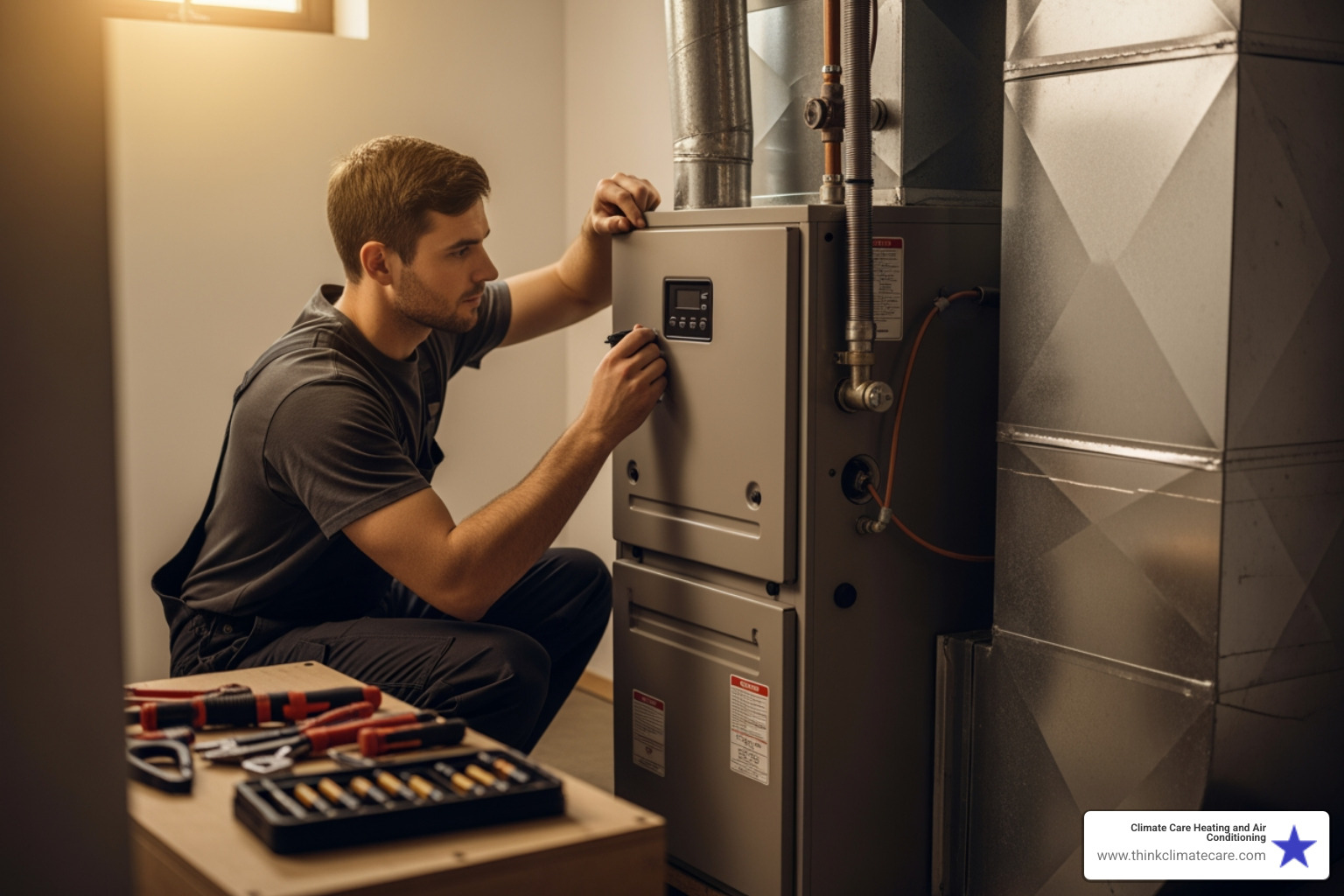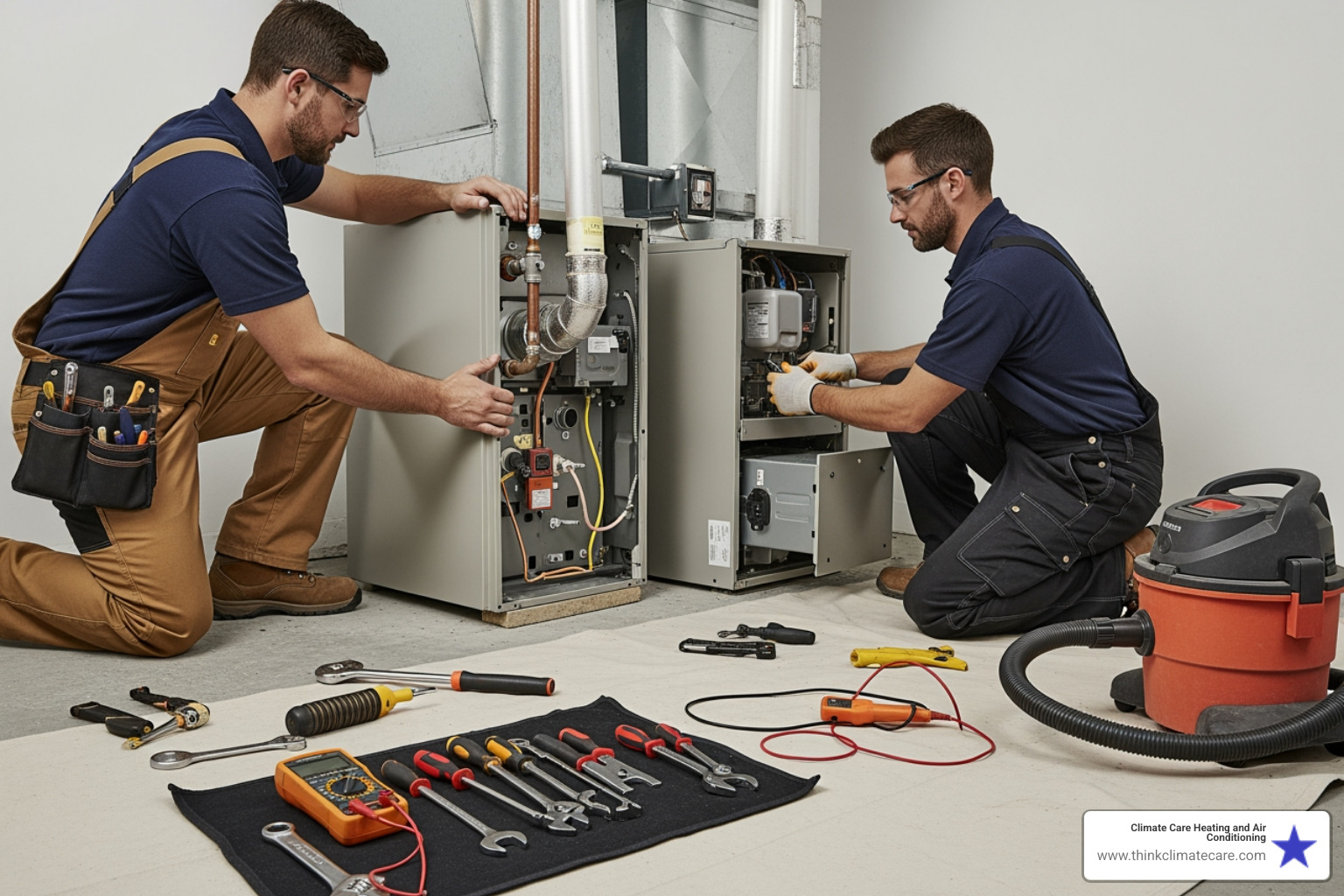The Chill is Gone: What to Do When Your AC Stops Cooling

Why Your Home Feels Warm: Understanding AC Cooling Problems
When your HVAC system not cooling your home, it's often due to a few common culprits. Here are the most frequent reasons:
- Dirty Air Filter: A clogged filter restricts airflow, making your AC work harder and cool less effectively.
- Incorrect Thermostat Settings: The thermostat might be set to "fan" instead of "cool," or the temperature is too high.
- Dirty Outdoor Unit: Debris can block the outdoor condenser unit, preventing it from releasing heat properly.
- Low Refrigerant: If your system is low on refrigerant, it means there's a leak, and it can't absorb enough heat from your home.
- Frozen Evaporator Coil: Ice can build up on the indoor coil, blocking airflow and preventing cooling.
We've all felt it. That moment when you walk into your home, expecting cool comfort, but instead, it's just as warm, or even warmer, inside than out. The chill is gone. An air conditioner is essential for keeping your home comfortable, especially during hot summers. So, when your AC stops blowing cold air, it can be frustrating and even concerning.
This guide is designed to help you. We'll explore the common reasons your AC might not be cooling properly. You'll learn simple checks you can do yourself to identify the problem. And we'll help you understand when it's time to call a professional for expert repair. Our goal is to help you restore comfort and peace of mind in your home.
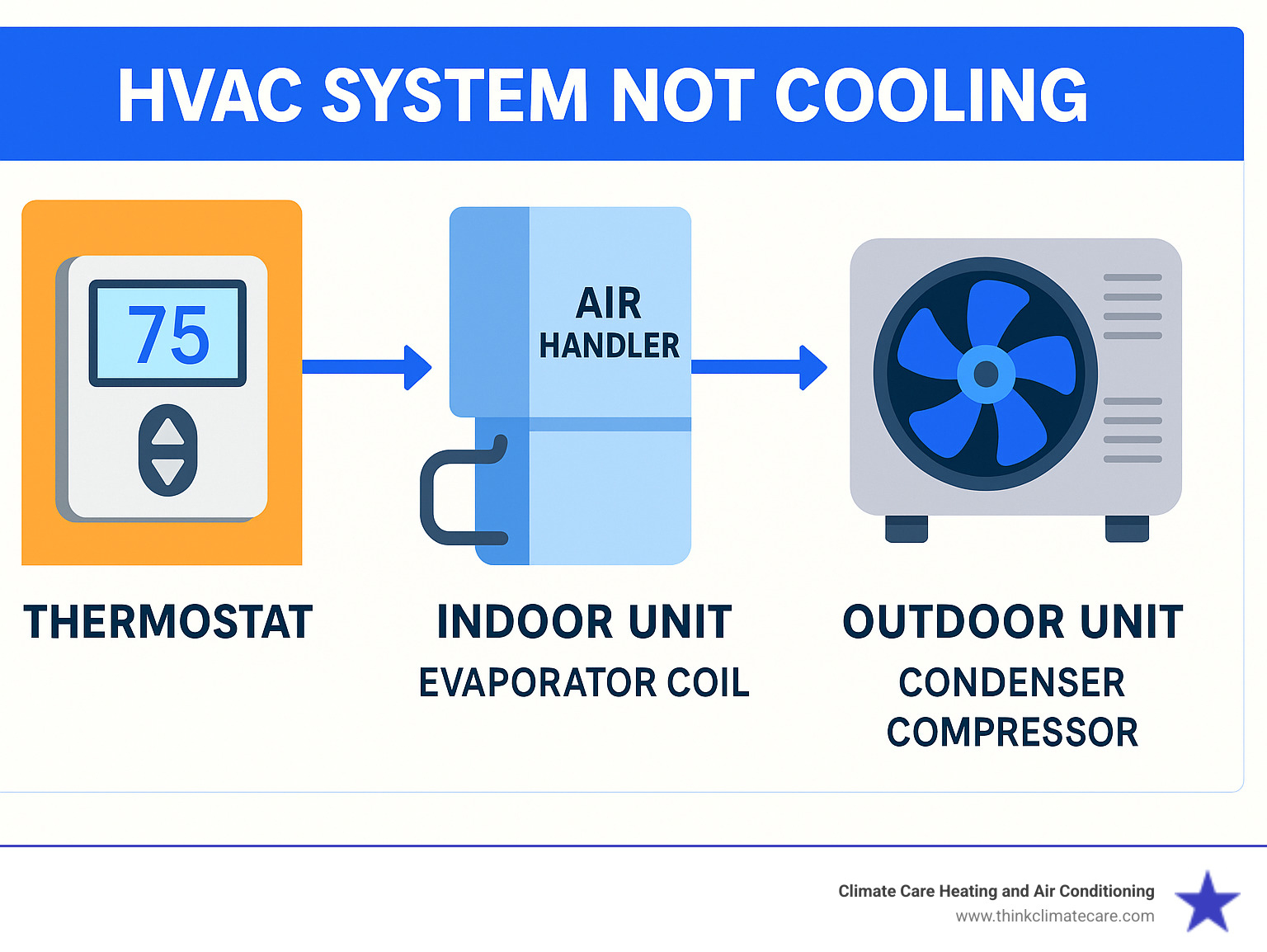
First Steps: Simple DIY Checks for Your AC
Before you panic and start imagining a sweltering summer ahead, take a deep breath. The good news? Many times when your HVAC system not cooling properly, the fix is surprisingly straightforward. You might even solve the problem in just a few minutes without needing to call anyone.
We always encourage homeowners to try these basic troubleshooting steps first. Not only can they save you time and money, but they'll also help you better understand your system. Think of it as getting to know your home's cooling personality a little better.
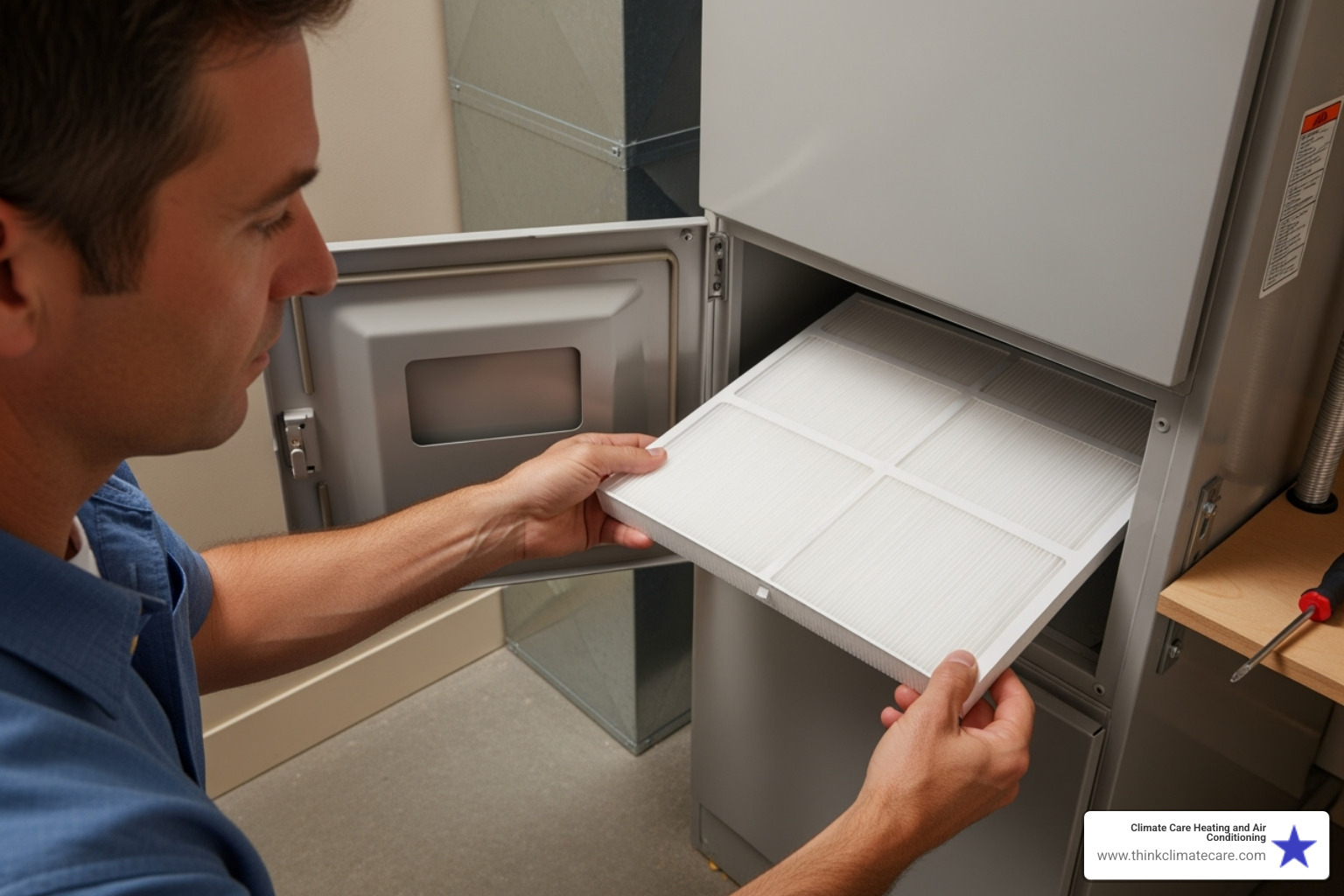
Check Your Thermostat Settings
Here's something that might surprise you: incorrect thermostat settings are one of the most common reasons we get called out, and honestly, it happens to the best of us. It's like having your car in park and wondering why you're not moving forward!
Start with the basics. Make sure your thermostat is actually set to "Cool" mode rather than "Heat" or just "Fan." You'd be amazed how often this simple oversight is the culprit. Maybe someone in the house accidentally bumped it, or perhaps you switched it during a recent cool spell and forgot to change it back.
Next, check your fan setting. If it's set to "On" instead of "Auto," your fan will blow constantly, but the cooling system won't necessarily be running. This means you're just circulating the same warm air around your house. Switch it to "Auto" so the fan only runs when your system is actually cooling.
Now, look at your temperature setting. Is it actually lower than your current room temperature? Your AC won't kick in if you've set it to 78°F but your house is already sitting comfortably at 75°F. For the best balance of comfort and efficiency, we typically recommend keeping your thermostat around 75°F during the day.
If you have a smart thermostat, double-check that a programmed schedule isn't overriding what you think you've set. These clever devices sometimes have a mind of their own! And here's a simple one that catches people off guard: if your thermostat uses batteries, make sure they're not dead. A thermostat with dying batteries can act unpredictably or go completely blank.
Inspect the Air Filter
Think of your air filter as your HVAC system's lungs. When those lungs get clogged up with dust, pet hair, and all the stuff floating around your home, your system simply can't breathe properly. This is actually one of the most frequent reasons behind an HVAC system not cooling effectively.
A clogged air filter creates a domino effect. Your system has to work much harder to pull air through that dirty barrier, which means less air actually makes it to your cooling coils. Less airflow equals less cooling power, and before you know it, you're sweating while your poor AC is gasping for air.
We recommend checking your filter monthly and replacing it every 1-3 months, depending on your household. Got pets? You might need to change it more often. Live in a dusty area? Same story.
Here's how to tell if your filter needs attention: visible dust and debris that makes the filter look gray or brown instead of white, weak airflow from your vents that feels less powerful than usual, musty smells when your system runs, or even ice buildup on your indoor unit in severe cases. You might also notice your energy bills creeping up as your system works overtime.
The good news? Swapping out a dirty filter is one of the easiest fixes you can do. While a clean filter won't make your air colder by itself, it helps your system run efficiently, which means more consistent and effective cooling throughout your home.
Check the Circuit Breaker and Power
Sometimes the simplest answer is the right one: your AC might just not be getting the power it needs. It's like trying to start your car with a dead battery – nothing's going to happen, no matter how perfectly everything else is working.
Start by taking a trip to your home's electrical panel. Look for a breaker labeled something like "AC," "HVAC," or "Furnace." If it's tripped, you'll usually see it sitting in the middle position or flipped to "off." When breakers trip, they're doing their job – protecting your home from electrical overload.
To reset a tripped breaker, flip it firmly to the "off" position first, then back to "on." Don't just try to push it to "on" from the middle position – it won't reset properly that way.
Here's an important warning: if the breaker trips again immediately or within a short time, stop trying to reset it. This tells you there's a deeper electrical problem or an issue with your unit that needs professional attention. Repeatedly resetting a breaker that keeps tripping can be dangerous.
Next, head outside to your outdoor condenser unit. Near the unit, you'll find a small electrical box mounted on the wall – this is your disconnect switch. Make sure the switch inside is in the "on" position. Sometimes these get accidentally turned off during yard work, or a recent storm might have affected them.
After checking both the breaker and the outdoor disconnect, give your system about 5-10 minutes to reset before expecting cold air. Your AC's electronic controls need a moment to get their bearings, especially if there was a power surge or outage recently.
Investigating Airflow: From the Coils to the Vents
Even with a clean filter and your thermostat set just right, an HVAC system not cooling might still be struggling. Why? Because airflow issues can happen beyond just that simple filter, impacting your system's ability to transfer heat effectively. These problems can pop up both inside and outside your home, making your AC work overtime without delivering the comfort you crave.
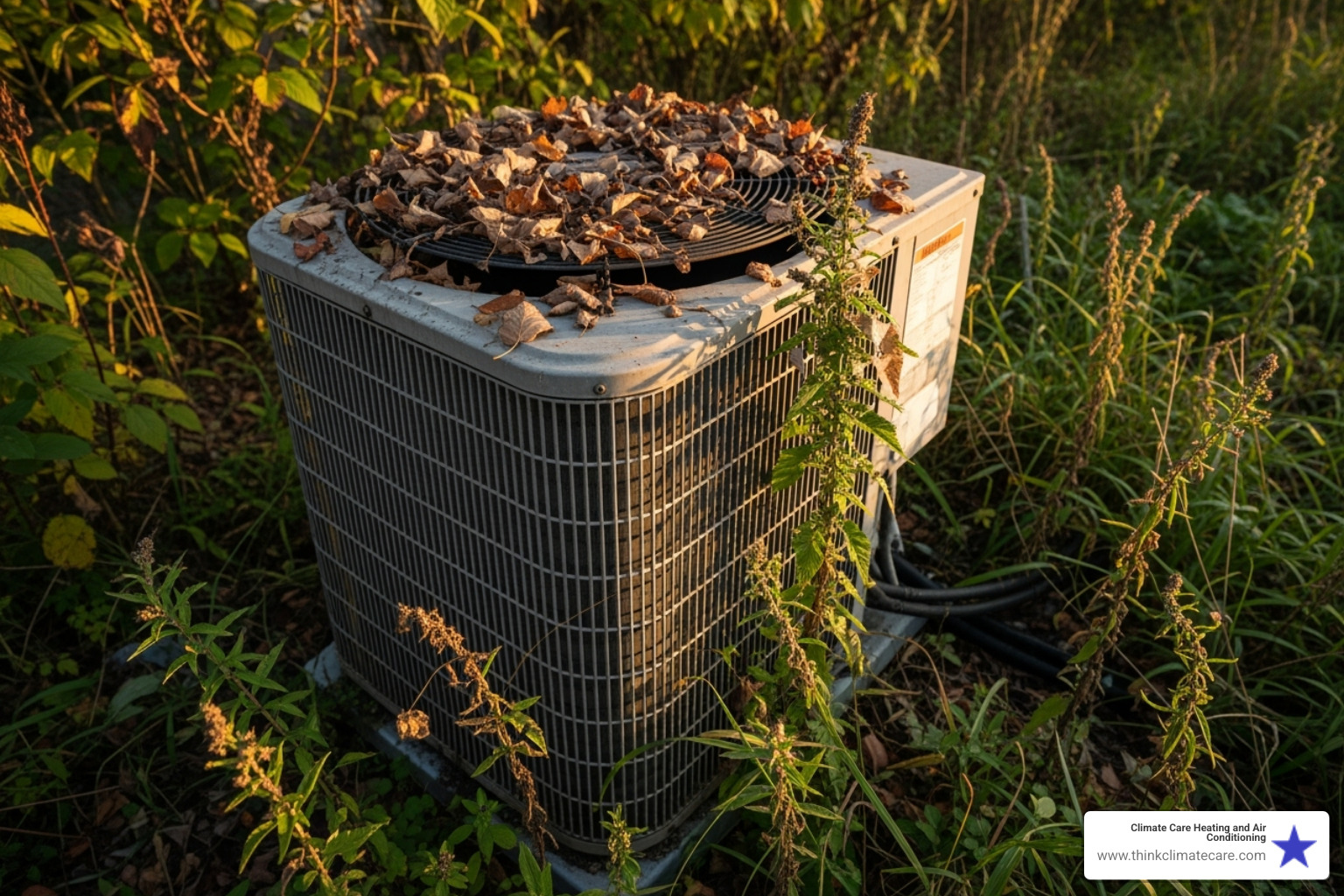
The Problem with a Dirty or Blocked Outdoor Condenser Unit
Imagine trying to cool off on a hot day while wearing a thick, fuzzy blanket. That's a bit like what happens when your outdoor condenser unit is dirty or blocked! This part of your AC system is a real workhorse. It's where all the heat your system pulled from inside your home finally gets released into the outside air.
However, if this unit is covered in debris, it can't do its job properly. Over time, it can gather leaves, grass clippings, dirt, and other gunk. We've even seen overgrown shrubs or fences built too close to the unit. This buildup acts like that thick blanket, trapping heat and preventing your AC from cooling your home effectively. When your condenser can't dissipate heat, your system has to work much harder, leading to reduced efficiency, higher energy bills, and potentially serious damage to the compressor from overheating. We always recommend keeping at least two feet of clear space around your outdoor unit. A gentle rinse with a garden hose can help clear surface debris, but for a truly deep clean, it's best to leave it to our professionals during your annual maintenance visit.
Why a Frozen Evaporator Coil Stops Cooling in its Tracks
Have you ever tried to breathe through a block of ice? It's impossible! And that's pretty much what happens when your evaporator coil freezes over. This coil is tucked away inside your indoor unit (usually with your furnace or air handler), and its main job is to absorb heat and humidity from your home's air. When it's covered in ice, it can't do its job, and your HVAC system not cooling becomes a very literal, chilly problem (but not in a good way!).
You'll spot a frozen evaporator coil by a few tell-tale signs. You might see visible ice or frost on the refrigerant lines near your air handler, or even on the coil itself if you can safely peek. Even with a clean filter, the airflow from your vents might feel significantly weaker. As the ice melts, it can overflow the drip pan, leading to water leaks from your indoor unit. And, of course, the air coming from your vents will feel warm or only slightly cool.
So, why does it freeze? The two main reasons are restricted airflow and low refrigerant levels. Restricted airflow, often caused by a dirty air filter (see, it all ties together!), closed vents, or blocked return air ducts, means not enough warm air passes over the coil to keep it from getting too cold. If your air conditioner is low on refrigerant, likely due to a leak, the pressures drop, causing the refrigerant to get so cold that any moisture in the air literally freezes onto the coil.
If you find a frozen coil, your first step is to turn off your AC unit immediately. Please, whatever you do, don't try to chip away the ice! Instead, switch your thermostat to "Fan On" (if your thermostat has this setting). This helps melt the ice by circulating warmer air over the coil. Give it plenty of time to thaw completely – this can take anywhere from 12 to 24 hours. Once it's thawed, remember to address the underlying cause, like replacing that dirty filter or clearing blocked vents. If the problem keeps happening, especially if you suspect a refrigerant leak, it's definitely time to call in a professional from Climate Care.
Unblocking Vents and Ducts
Airflow isn't just about filters and coils; it's also about how that perfectly cooled air actually makes it throughout your home. Blocked vents and leaky ductwork can seriously mess with your AC's ability to cool your home evenly and efficiently.
First, take a stroll around your home and check all your supply vents. Are any of them closed or blocked by furniture, curtains, or rugs? It might seem like a smart idea to close vents in rooms you don't use much to save energy, but it actually restricts the overall airflow. This forces your AC unit to work harder, potentially leading to bigger cooling issues or even premature wear and tear on your system. We always recommend keeping all your vents open to ensure proper air circulation and system balance.
Next, let's talk about your ductwork. Think of your ducts as the highways that deliver cool air from your AC unit to every corner of your living spaces. If these highways have leaks, cracks, or poor seals at the joints, that precious cool air can escape into unconditioned areas like your attic, crawl space, or even inside your walls. This means your AC is busily cooling spaces you don't even use, while your main living areas stay warm. Leaky ductwork can also pull in unconditioned air or even contaminants, further reducing efficiency and affecting your indoor air quality. While some small leaks might be obvious, significant duct issues often need a professional inspection and sealing. If you notice certain rooms are always much warmer than others, this uneven cooling could point to a blocked vent in that area or a larger ductwork problem.
When Your HVAC System Not Cooling Points to a Deeper Problem
Sometimes, even after checking all the basics, your HVAC system not cooling might still be struggling. When simple fixes don't solve the problem, it's usually pointing to something more serious happening under the hood. Think of it like having a persistent cough – while it might start as something minor, if it doesn't go away, there's probably a deeper issue that needs professional attention.
These more complex problems typically involve the mechanical heart of your system or its electrical components. While it's tempting to try fixing everything yourself, some repairs require specialized knowledge, tools, and safety training. More importantly, attempting these repairs on your own can actually make the problem worse or even dangerous.
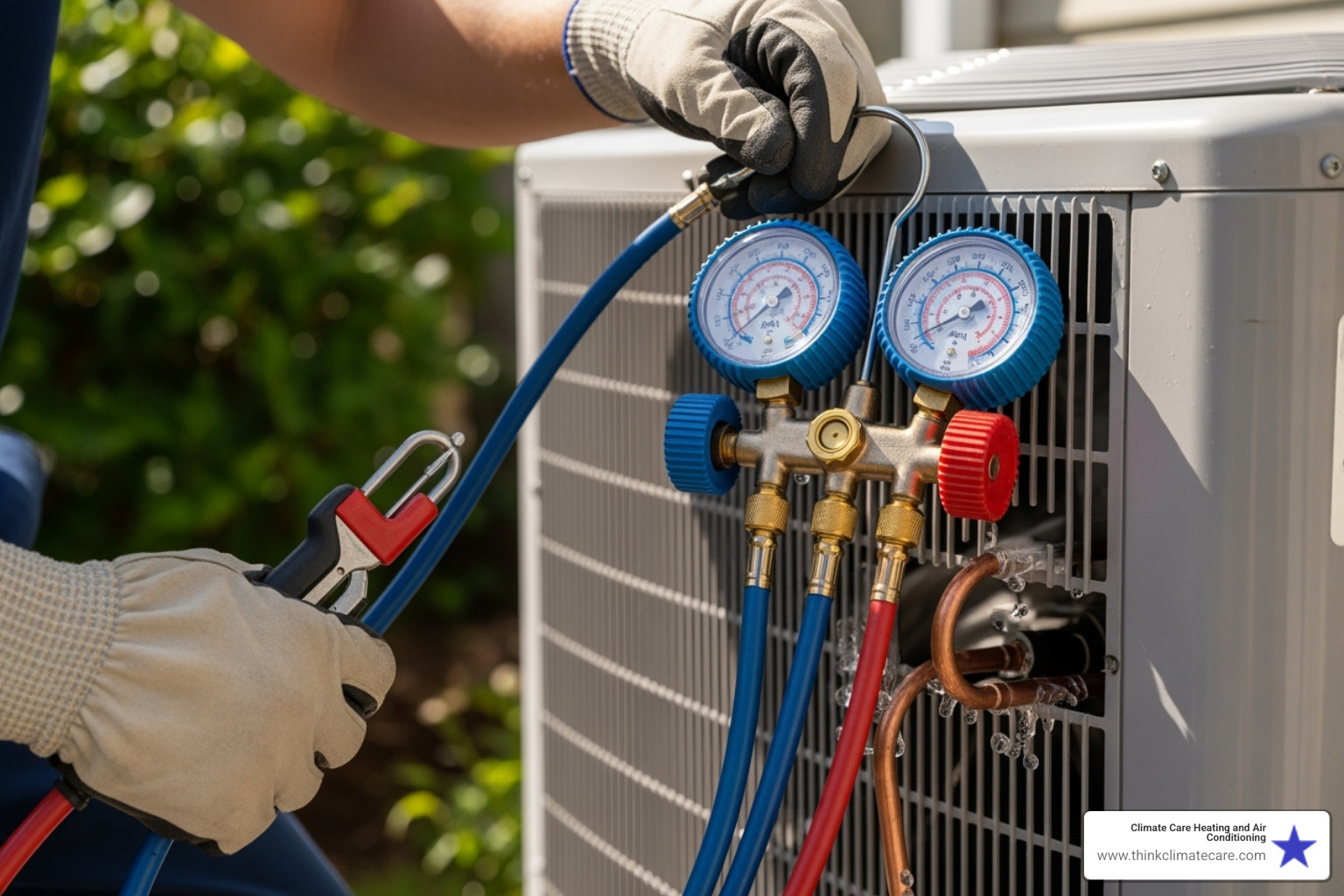
Understanding Refrigerant Leaks and Their Impact on an HVAC system not cooling
Your AC's refrigerant is like the blood in your veins – it needs to keep circulating to keep everything working properly. This specialized chemical moves through your system in an endless loop, picking up heat from inside your home and dumping it outside. Here's the key thing: refrigerant doesn't get "used up" like gas in your car. If your system is low on refrigerant, that means it's leaking somewhere.
When refrigerant leaks out, your AC simply can't do its job. There's not enough of this heat-carrying fluid to move the warmth from inside to outside. You might notice your system blowing warm air even though it's running constantly, or you might hear hissing or bubbling sounds – that's often the sound of refrigerant escaping through a crack or loose connection.
Refrigerant leaks create a cascade of problems. Your system works harder and harder, trying to cool your home with insufficient refrigerant. This extra strain can damage the compressor, which is expensive to replace. Meanwhile, many refrigerants are potent greenhouse gases, so leaks harm the environment. Plus, these chemicals require special handling and certification to work with safely.
If you suspect a refrigerant leak, resist the urge to add more refrigerant or attempt a repair yourself. Only certified HVAC technicians have the proper tools and training to locate the leak, fix it correctly, and recharge the system to the right levels. For more detailed information about common AC issues like this, the Common air conditioning problems guide from the U.S. Department of Energy offers helpful insights.
Signs of a Failing Compressor or Electrical Fault
The compressor is truly the heart of your cooling system. Sitting in that outdoor unit, it's responsible for pressurizing the refrigerant so it can effectively carry heat away from your home. When the compressor starts failing, your HVAC system not cooling becomes inevitable – it's like trying to pump water with a broken heart.
Loud or strange noises are often the first warning sign. You might hear grinding, rattling, or a loud buzzing when the outdoor unit tries to start. Sometimes the system won't start at all, or it might struggle to turn on and then quickly shut down. If your circuit breaker keeps tripping when the AC tries to run, that's another red flag – a failing compressor can draw way more electricity than it should.
The most obvious sign is warm air coming from your vents even though the indoor fan is running. This means the compressor isn't doing its job of cooling the refrigerant.
Another sneaky culprit behind cooling failures is a failing capacitor. These small, cylindrical components provide the electrical "boost" needed to start your compressor and fan motors. Think of them like the starter in your car – when they fail, nothing else can get going. A bad capacitor might cause the same symptoms as a failing compressor, which is why professional diagnosis is so important.
Electrical faults can be particularly tricky because they're not always obvious. The system might seem fine on the surface, but electrical components can fail gradually or intermittently. Attempting to diagnose or repair electrical issues yourself isn't just ineffective – it's genuinely dangerous and could damage your system further.
When you're dealing with compressor problems or electrical faults, it's definitely time to call in the professionals. These repairs require specialized tools, safety training, and experience that comes from years of working on HVAC systems.
Frequently Asked Questions about AC Cooling Issues
When your HVAC system not cooling properly, you probably have a lot of questions running through your mind. We've been helping homeowners in Manteca for years, and these are the questions we hear most often. Let's tackle them together!
Why is my AC running but not blowing cold air?
This has to be the most frustrating situation - your AC sounds like it's working hard, the fan is humming along, but you're getting nothing but warm air for your efforts. It's like ordering an iced coffee and getting hot tea instead!
The good news is that this problem usually has a fixable cause. Most often, it's a dirty air filter that's choking your system's airflow. When your filter is clogged with dust and debris, your AC can't breathe properly, and cooling efficiency plummets.
Low refrigerant is another common culprit. If you hear hissing or bubbling sounds, that's your system literally leaking its cooling power. Refrigerant doesn't get "used up" - if it's low, there's definitely a leak somewhere that needs professional attention.
Your outdoor condenser coils might be buried under months of dirt, leaves, and debris. When these coils can't release heat properly, your entire system struggles to cool. It's like trying to cool off while wearing a winter coat!
Don't forget to double-check your thermostat settings too. We've seen plenty of cases where the thermostat was set to "fan" instead of "cool," or someone accidentally bumped the temperature up. Sometimes the simplest explanation is the right one.
A frozen evaporator coil can also cause this problem. When ice builds up on your indoor coil, it blocks heat absorption completely. And if your compressor - the heart of your cooling system - is failing, you might hear strange noises from the outdoor unit, or it might not run at all.
Should I turn my AC off if it's not cooling?
Absolutely, yes! This might seem counterintuitive when you're desperate for cool air, but running a malfunctioning AC is like driving a car with a flat tire - you're only making things worse.
Preventing damage is the biggest reason to shut it down. When your system runs with low refrigerant or restricted airflow, it puts tremendous strain on the compressor. This can turn a relatively simple repair into a major, expensive replacement.
If you notice ice buildup, continuing to run the system will only create more ice, making the problem harder to diagnose and fix. Your compressor strain increases dramatically when it's fighting against these issues, and we've seen units fail completely because homeowners kept them running despite obvious problems.
You're also just wasting energy at this point. Running an inefficient system that's not cooling is like leaving money on your utility company's doorstep. Turn it off, take a deep breath, and work through those basic troubleshooting steps we covered earlier.
If the simple fixes don't work, leave the system off and give us a call. Your AC will thank you, and so will your wallet.
Does cleaning the AC filter really make the air colder?
Here's where we need to bust a common myth! Cleaning your filter won't actually make the air coming out of your vents any colder than it was designed to be. Your AC's refrigeration cycle determines the actual temperature of the air, and a clean filter can't change that.
But here's what a clean filter does do - and why it matters so much for your comfort. Improved airflow is the key. When air can flow freely through a clean filter, more warm air passes over your evaporator coil. This means your system can absorb heat more effectively from your home.
Think of it this way: airflow versus temperature are two different things. Your AC might be capable of producing 55-degree air, but if a dirty filter is blocking that cold air from reaching your rooms, you'll never feel it. A clean filter ensures you actually get the cooling performance your system was designed to deliver.
System efficiency improves dramatically with a clean filter. Your AC doesn't have to work as hard to pull air through the system, which means it can operate closer to its peak performance. This translates to more consistent cooling throughout your home and lower energy bills.
So while cleaning your filter won't drop the air temperature by an extra 10 degrees, it will help ensure your HVAC system not cooling problem gets resolved and stays resolved. It's one of the simplest yet most effective things you can do for your comfort!
Prevention and Professional Care: Keeping Your Cool All Season
When your HVAC system not cooling leaves you sweating, it's a stark reminder of how much we rely on our home comfort systems. While those simple DIY troubleshooting steps can solve many common issues, knowing when it's time to call in the professionals is absolutely key. It helps prevent further damage and ensures your system stays healthy for the long haul.
Here at Climate Care Heating and Air Conditioning, we truly believe in taking a holistic approach to HVAC care. What does that mean? Well, it's about more than just fixing problems when they pop up. It's about preventing them from happening in the first place! That's why regular maintenance is so important. Our comprehensive maintenance plans are carefully designed to keep your system purring at peak performance. They also help improve your home's cost-efficiency by cutting down on energy use, and even ensure we're doing our part for environmental standards. Think of it as a regular check-up for your AC – these routine tune-ups allow us to spot little issues before they snowball into major, costly breakdowns. This not only saves you headaches but also extends the life of your unit, keeping your home wonderfully comfortable.
We're proud to serve numerous communities across California, including Manteca, Mountain House, Ripon, Sacramento, Stockton, Tracy, and many more. Our team of technicians isn't just skilled; they're NATE-certified experts! That means they're top-notch at diagnosing and repairing all makes and models of HVAC systems. Whether you need a routine check-up, a complex repair, or even a full system replacement, they've got you covered.
So, if you've tried all the DIY steps we talked about, and your AC is still not cooling – or if you suspect something more serious like a refrigerant leak, a compressor problem, or an electrical fault – please don't hesitate to reach out. Our friendly team is ready to provide expert Professional heat pump and AC repair services to get your system back on track. Your comfort is always our top priority, and we're here to make sure that delightful chill returns to your home, swiftly and efficiently!
Customer Testimonials
Our customers love our service and support.











